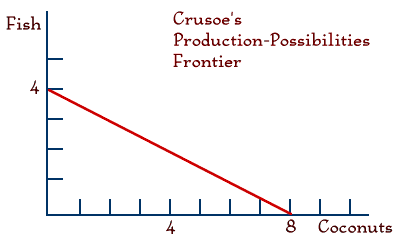Production Possibilities
Scarcity is the basis of many economic concepts because it constrains or limits our behavior. Let us explore the notion of constrained behavior by starting with the simplest sort of economic structure, Robinson Crusoe alone on his island.
Suppose that each day Crusoe has enough time to catch four fish or to gather eight coconuts. Notice that he cannot have both four fish and eight coconuts. If he uses his time to catch fish, he does not have that time to find coconuts. If he wants both coconuts and fish, he can devote some time to both. If, for example, he spends half the day fishing and the other half-day gathering coconuts, he can have two fish and four coconuts.
A list of all the possible combinations of fish and coconuts open to Crusoe makes up his production possibilities. The production-possibilities frontier separates outcomes that are possible for an individual (or a group) to produce from those that cannot be produced. Because Crusoe cannot exchange, his production-possibilities frontier is also his consumption-possibilities frontier. The consumption-possibilities frontier (sometimes called the budget constraint) is the line indicating which outcomes are affordable and which are not affordable. The graph below illustrates Crusoe's production-possibilities frontier (and his consumption-possibilities frontier). Be sure you understand that the information in the table above is exactly the same as the information in the graph below—these are two different ways of presenting that information.

The slope of the frontier in the graph above measures the costs facing Crusoe. In order to get an extra fish, he must sacrifice two coconuts, and to get another coconut, he must sacrifice one-half of a fish. Notice that there is no money involved; cost does not depend on money, but rather exists whenever there is scarcity and choice. In economics, the cost of anything refers to whatever is given up in order to get that thing. The cost of going to college, for example, includes not only the money a person spends on tuition (which could be spent on something else), but also includes the time spent studying and going to classes. The value of this time can be estimated by computing the amount of income a person could earn if he did not go to college.
If you reflect on this table, you will see the importance of scarcity. You can think of the production-possibilities frontier as the way economists visualize scarcity. Which of the options will he choose? We cannot tell because we can only compute costs from this information, not benefits. The favorite assumption of economists is that individuals base their actions on the costs and benefits that they see. Benefits depend on the goals Crusoe has, and the production-possibilities frontier has no information about them.
Next we see what production-possibilities frontiers tell us about exchange.
Copyright Robert Schenk